An A to Z Guide to American Motorcycles
An A to Z Guide to American Motorcycles
People often think of the United States as a two-company country when it comes to motorcycles: Harley and Indian. But obviously that's incorrect. Not only are there more than just two current companies currently building motorcycles in the United States, there are hundreds of names to choose from in the country's past. Almost every letter of the alphabet is represented.
The original motorcycle boom of 1890 - 1930, saw hundreds of ambitious manufacturers rise and fall around the world. The scramble to secure a share of the rapidly emerging market for two wheelers was especially keen in the United States, with its growing economy, industrial resources, and expanding immigrant labor force. Capitalism was on a roll.
Economical transportation was the key focus for most of the early builders; the notion of motorcycles as recreational devices gathered momentum in the States only after Henry Ford made cars the more affordable choice. As the rational replacement for the horse and buggy, the automobile became the sensible option. But the core group of bicycle riders – racers especially – would persist. They held fast to the certainty that the need for speed and the thrill of riding solo with the wind in their face, would ultimately lead to success in the expanding motorcycle marketplace. The few companies that made it through the second half of the 20th century were lucky enough to have excellent engineers and designers with persistence and vision – and it helped to have a belief that the motorcycle was God’s own choice to replace the horse and the bicycle. To hell with the buggy.
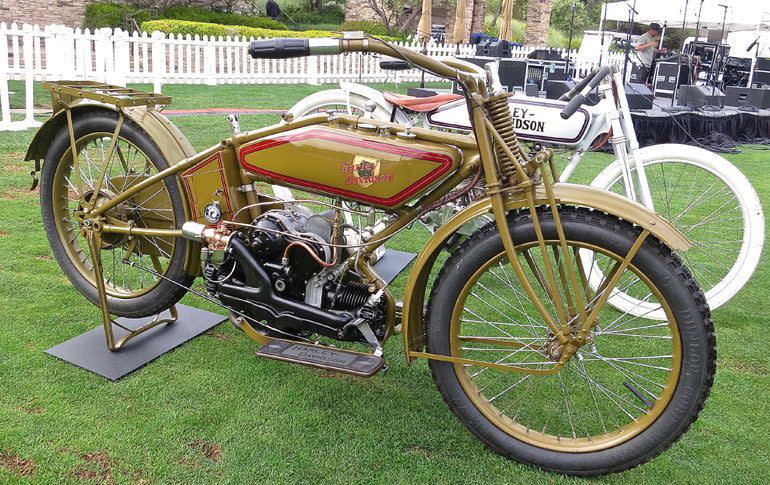
So, herewith you will find the most complete list of American motorcycles we could dig up, with the disclaimer that a few may have been overlooked by virtue of their quite limited production and/or commercial availability. Should you note any glaring omissions, incorrect names, locations, dates or generally inaccurate or misleading information, feel free to bring it to our attention, so we can dial this article in even further.
(Note: For reasons of logistics and drawing the line somewhere, we have omitted a number of one-offs, companies that lasted only one year, and a dozen or so Harley clones of more recent years [ e.g. Big Dog]. A list that would include those machines would bring the total of American motorcycle manufacturers who did some business in the 20 century to right around 300. Forgive our brevity.)
(A)
ACE (1920–1927) Philadelphia, Pennsylvania – The Ace 1262cc inline four was the final iteration of the Henderson marque (See below), established in 1912. The engine made 45 horsepower, the machine weighed just under 300 pounds, and in 1923 it laid claim to the title of “Fastest Motorcycle in the World” with a documented run of 130 mph.
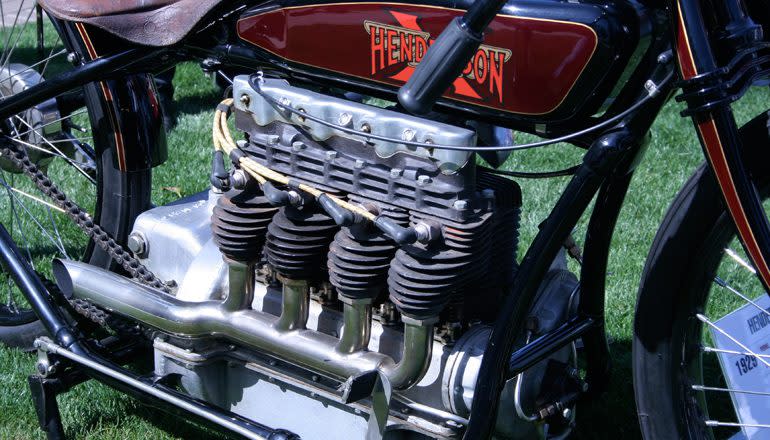
AMC (1912–1915) Chicago, Illinois
AMERICA (1904–1906) La Porte, Indiana
AMERICAN (1902–1910) Chicago, Illinois – Also sold under the brands Columbia, Tribune, Rambler and Crescent.
AMERICAN (1911–1914) Chicago, Illinois
ARMAC (1902–1913) St. Paul, Minnesota – The three-horsepower 376cc single was designed by A. J. McCollum. It was offered with either belt or chain drive and, perhaps much to Erik Buell's dismay, was one of the first motorcycles to house both fuel and oil within the frame. Weight was roughly 150 lbs., and the price was a paltry $200.
APACHE (1907–1911) Denver, Colorado
ARGYLE (1950–1961) Memphis, Missouri
ARROW (1909–1916) Chicago, Illinois – Sold under license from Marsh-Metz, the 500cc single also appeared under the names Peerless, National and Haverford. Rebadged marques soon outstripped the demands of the market.
ATK (1987– ) Centerville, Utah – Founded by chain-tensioner designer Horst Leitner, these innovative off-road bikes were powered by an air-cooled Rotax single. The company now maintains a supply of ATK and Cannondale parts for the many faithful owners of both brands.
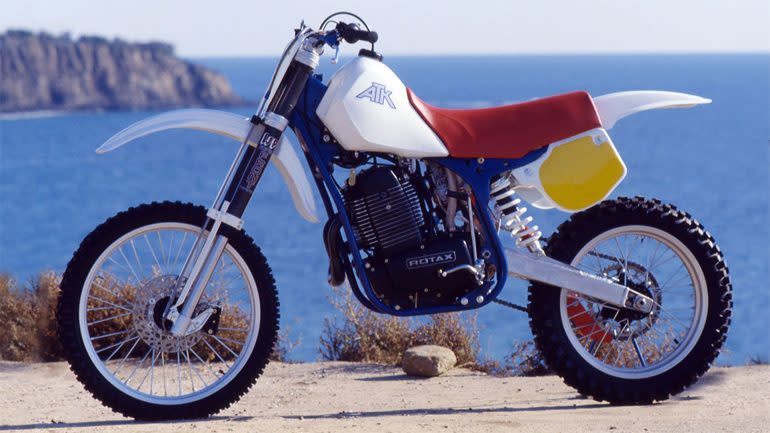
AUTO-BI (1900–1912) Buffalo, New York – Arguably the first production motorcycle in America, the first Auto-Bi was powered by a 442cc single designed by E. R. Thomas. In 1905. Professional rider W. C. Chadeayne set a new coast-to-coast crosscountry record of 48 days on one of these sweet machines.
AUTOPED (1915–1921) New York, NY
(B)
BADGER (1919–1921) Milwaukee, Wisconsin
BAILEY (1913–1917) Portland, Oregon – The 67-cubic inch opposed twin was good for 9 horsepower, with crankshaft, gearbox and driveshaft on ball bearings. Designer Robert Bailey won a 180-mile enduro from Portland to Corvallis and back.
BOBCAT (1956–1960) Wheeling, Illinois
BRADLEY (1905–1912) Philadelphia, Pennsylvania
BUELL (1983–2009) / EBR (2009-2016) East Troy, Wisconsin – Designed by engineer/racer Erik Buell who had worked at Harley-Davidson. His first sportbikes used the Sportster engine, and H-D became a partner in 1993, later becoming the majority owner. By 2007 the company had produced 100,000 motorcycles, but two years later Harley dropped the brand. Erik Buell Racing (EBR) then built the racing 1125R powered by a Rotax V-twin, followed by a road model. After several attempts to revive production, EBR failed to find sufficient investment and was liquidated.
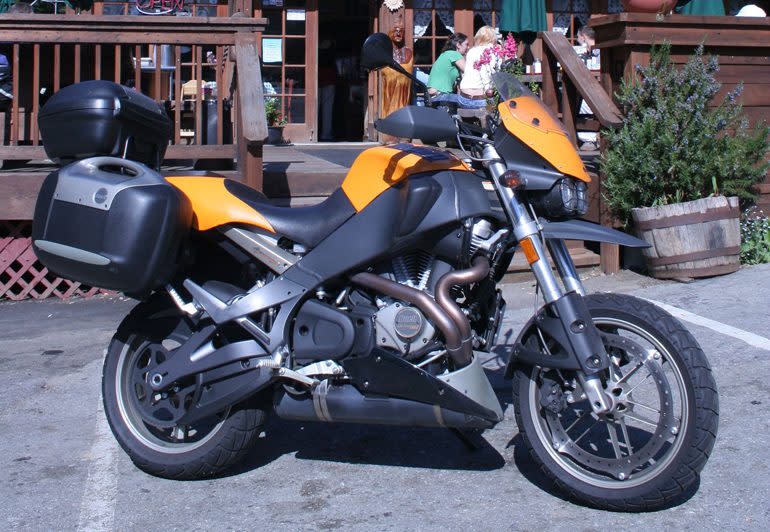
(C)
CALIFORNIA (1901–1903) San Francisco, California
CENTURY (1916–1917) Chicago, Illinois
CHAMPION (1911–1913) St. Louis, Missouri
CHICAGO (1904–1905) Chicago, Illinois
CLEMENS (1901–1903) Springfield, Massachusetts
CLEMENT (1903–1909) New York, New York
CLEVELAND (1902–1905 / 1915–1929) Hartford, Connecticut/Cleveland, Ohio – The Connecticut Clevelands were similar to the first Indians, but had a loop frame with the engine behind the center post. The later Ohio Cleveland was powered by a 220cc two-stroke single in a light (150 lbs) chassis and sold for $150. In the 1920s they introduced the inline four-cylinder four-stroke, designed by auto engineer L. E. Fowler. The 1000cc model was guaranteed for 100 mph.
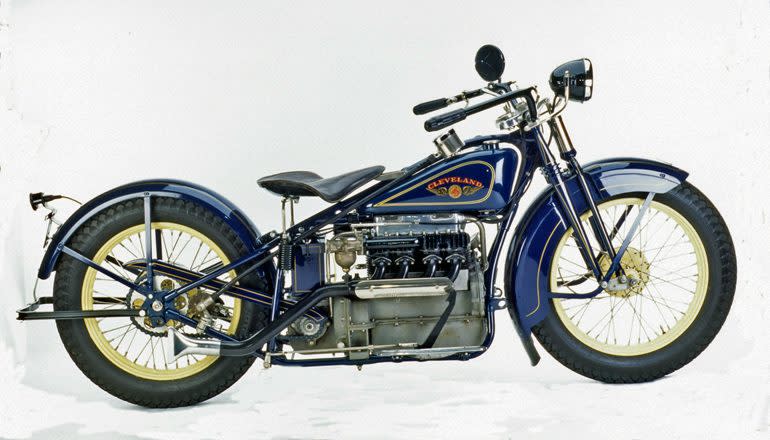
COLUMBIA (1902–1905) Chicago, Illinois
COMET (1909–?) Milwaukee, Wisconsin
CRAWFORD (1913-1914) Saginaw, Michigan
CRESCENT (1902–1905) Hartford, Connecticut
CROCKER (1934–1941) Los Angeles, California – Al Crocker was a design engineer at Thor in the 1910s, later became an Indian rep in Denver, then a dealer in Los Angeles. He and employee Paul Bigsby designed and built OHV single speedway bikes in the 1930s. Later, his famous 1000cc OHV V-twin, built to challenge Harley-Davidson, was light and powerful, but production hopes were squelched by World War II. About 100 Crocker twins were built.
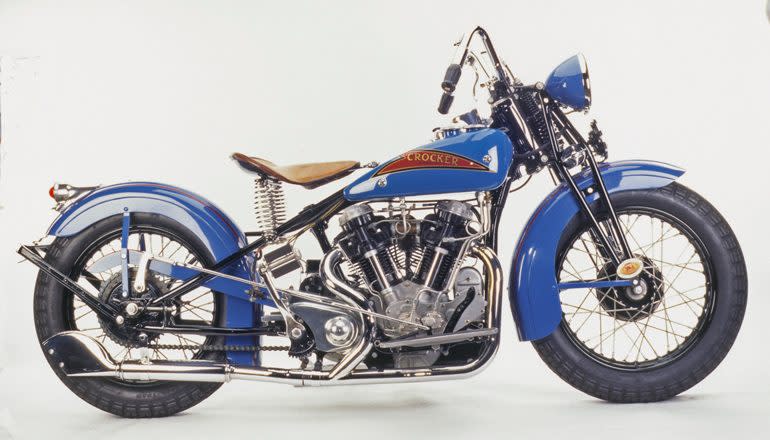
CROSLEY (1939–1952) Marion, Indian
CONFEDERATE (1996–present) Abita Springs, Louisiana
CROSLEY (1939–1952) Marion, Illinois
CROUCH (1905–1908) Stoneham, Massachusetts
CURTISS (1901–1913) Hammondsport, New York – Before Glenn Curtiss became an aviation pioneer he was a bicycle builder, racer, and motorcycle designer. His engineering credo was simple: more horsepower, less weight. Curtiss built the first production V-twin in 1903. In 1907 his V-8, developed for aircraft use, powered a 275 lbs. motorcycle to a record speed of 136 mph at Ormond Beach, Florida. When he moved on to the aircraft industry, Curtiss motorcycles were marketed under the Marvel name.
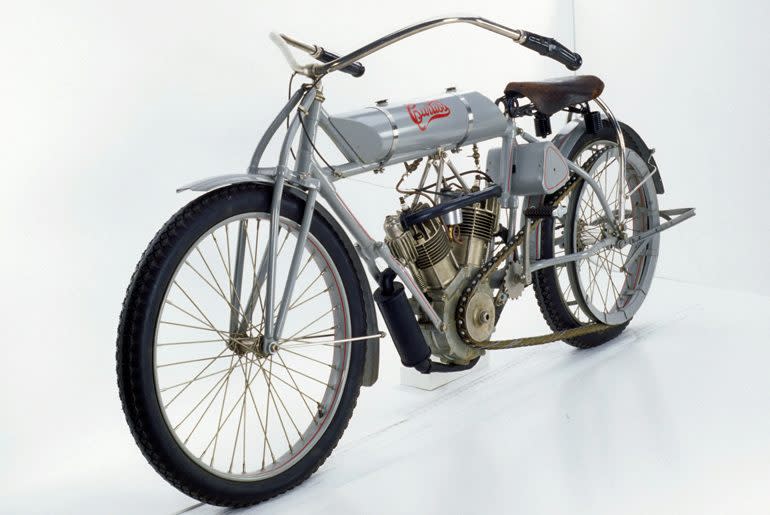
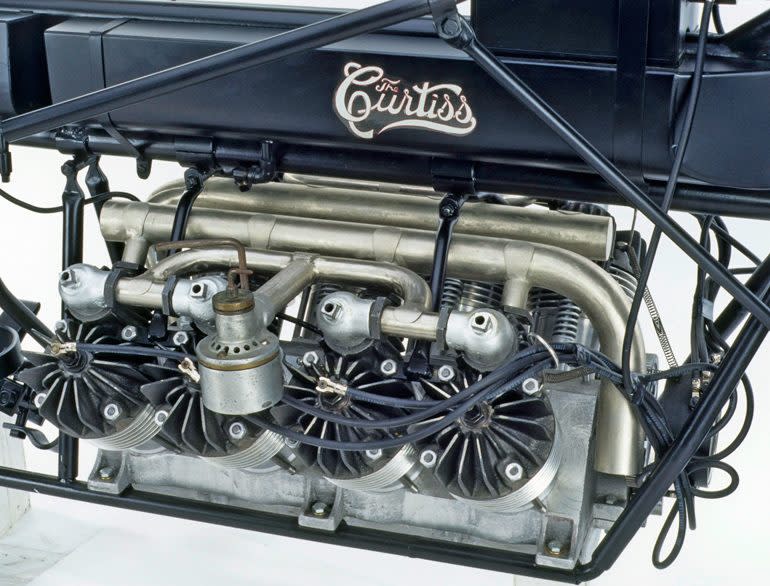
CUSHMAN (1936–1965) Lincoln, Nebraska
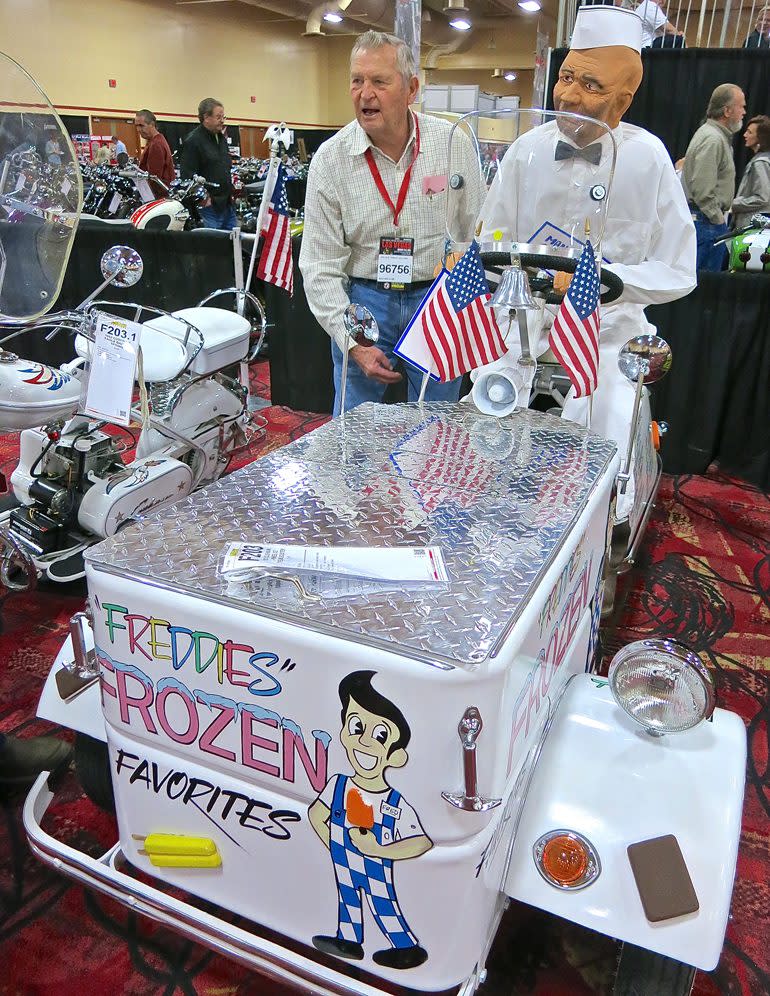
CVS (1911–1917) Philadelphia. Pennsylvania
CYCLEMOTOR (1916–1924) Rochester, New York
CYCLONE (1913–1916) St. Paul, Minnesota – The Joerns Motor Manufacturing Company set out to challenge industry leaders Indian and Harley-Davidson. Racer Don Johns, on the Cyclone 1000c OHV V-twin, posted a speed of 111 mph at a boardtrack in 1914. While the Cyclone was light and fast, it was also fragile, often breaking down in races. But the Model 7, effectively the first production cafe racer, was the fastest bike on the road in 1914.
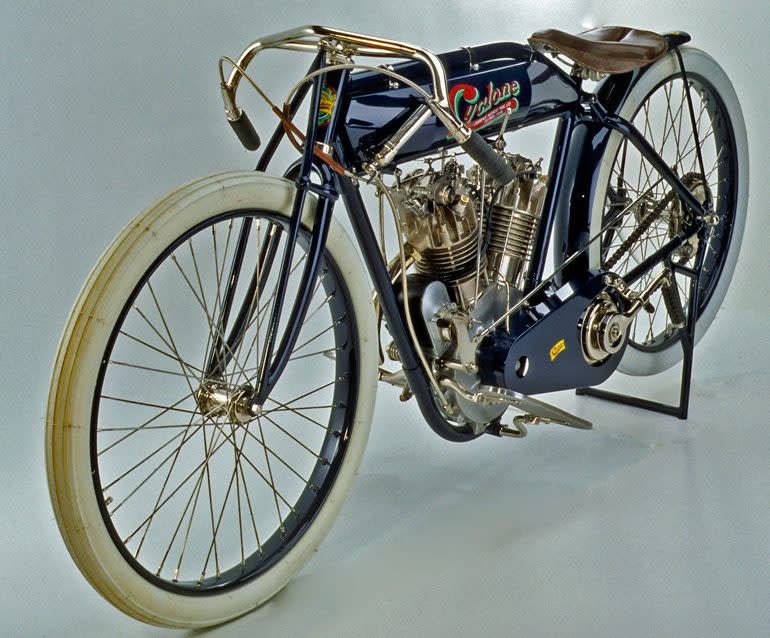
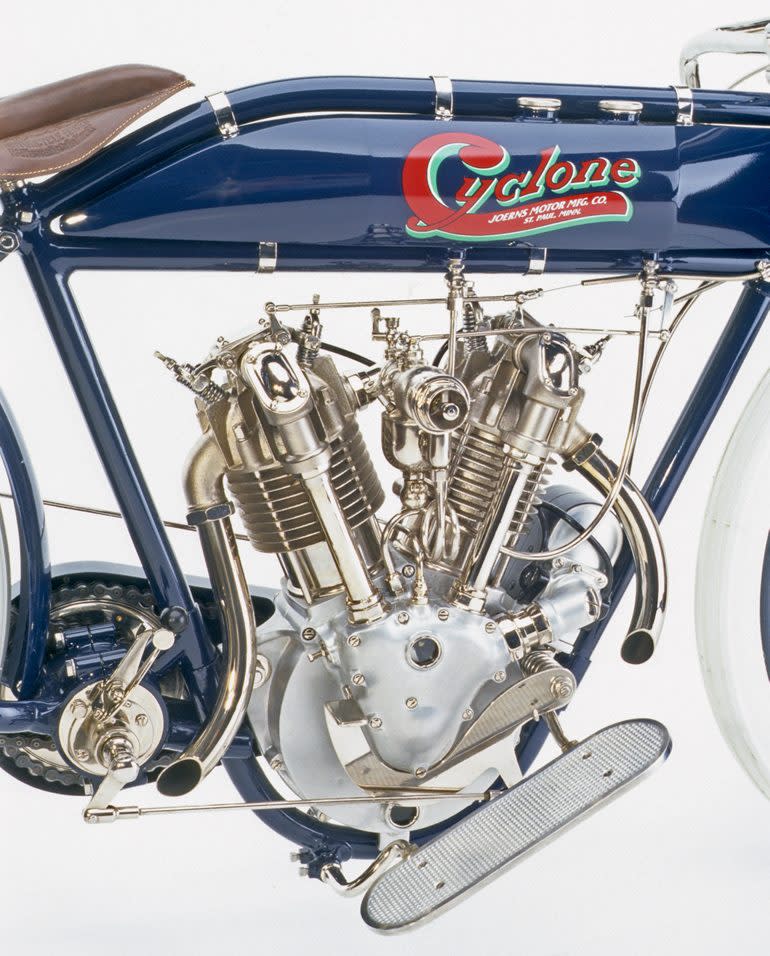
(D)
DAYTON (1911–1917) Dayton, Ohio
DELUXE (1912–1915) Chicago, Illinois
DETROIT (1911–?) Detroit, Michigan
DUCK (1903–1906) Stockton, California
DYKE (1903–1906) St. Louis, Missouri
DOODLE BUG (1946–1950) Webster City, Iowa
(E)
EAGLE (1909–1915) Brockton, Massachusetts
EMBLEM (1907–1925) Angola, New York – The first Emblem singles were offered with either direct drive or clutch, and flat- or V-belt drive. The 1255cc V-twin arrived in 1913, accompanied by an 800cc version. In 1917, a three-speed transmission was a $35 option. The Emblems were relatively light, nimble and economical, and gained popularity in export markets.
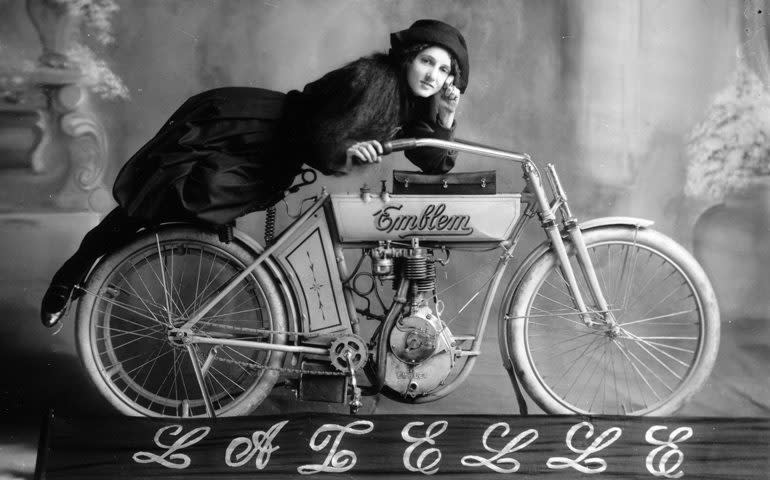
EMPIRE (1903–?) Addison, New York
ERIE (1906–1911) Hammondsport, New York
EVANS (1916–1924) Rochester, New York
EXCELSIOR (1908–1931) Chicago, Illinois – By 1911, Excelsior was one of the Big Three, behind Indian and Harley. The first 500cc singles had the crankcase cast integral with the frame. With Indian focused on the sportsman market, and H-D stressing reliability, Excelsior hoped to cover both bases. Given the growing popularity of motorcycle racing, they hired several top riders to contest the industry leaders. Lee Humiston logged the first 100 mph average at a Los Angeles boardtrack in 1913. The company was acquired by Schwinn Bicycles, which also bought the Henderson marque in 1917. Despite being competitive in flat track and hillclimb events, Excelsior wouldn’t survive the Great Depression.
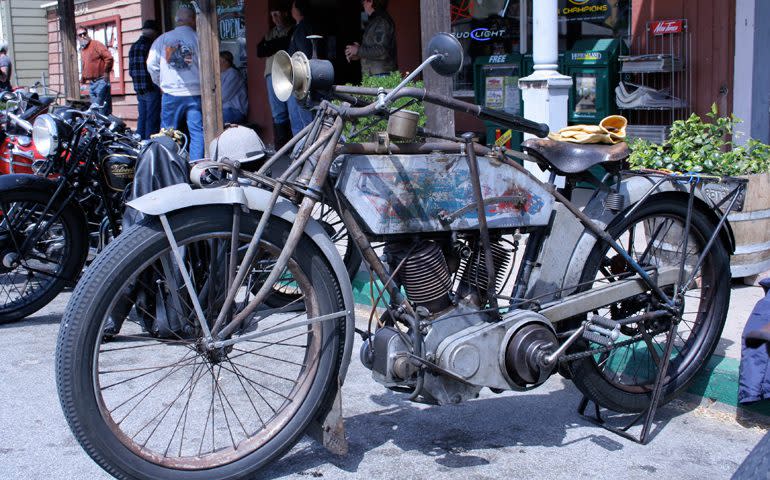
EXCELSIOR-HENDERSON (1998-1999) Belle Plaine, Minnesota
(F)
FEILBACH (1912–1913) Milwaukee, Wisconsin
FLANDERS (1911–1914) Detroit, Michigan
FLEMING (1900–1902) New York, New York
FRANKLIN (1899-1900) Mt. Vernon, Washington
FREYER + MILLER (1901–1907) Cleveland, Ohio
(G)
GERHART (1914–1916) Harrisburg, Pennsylvania
GREYHOUND (1907–1914) Aurora, Illinois – The first Greyhounds were powered by the Thor single, original provider of engines for Indian. The final iteration ran Auto-Bi engines, but the lightweight (130 lbs) machines fell short of the growing demand for powerful V-twins.

GLOBESTAR (1946-1949) Joliet, Illinois
GEER (1905–1909) St. Louis, Missouri
(H)
HAMPDEN (1901–1903) Springfield, Massachusetts
HARLEY-DAVIDSON (1903–present) Milwaukee, Wisconsin – William Harley and the three Davidson brothers comprised an uncommon combination of skills and ambition. With Harley, the designer/engineer, Arthur Davidson in marketing, brother William as shop foreman, and Walter as wrench and skilled rider, the Harley-Davidson Motor Co. had a strong foundation. By 1905 they had a production assembly line, and within two years had made about 200 motorcycles, by which time Indian had produced around 3,000 machines. In 1909, with the introduction of the V-twin, output rose to nearly 3,000 in Milwaukee. By 1910, total production was about a quarter of Indian’s, but the game was on.
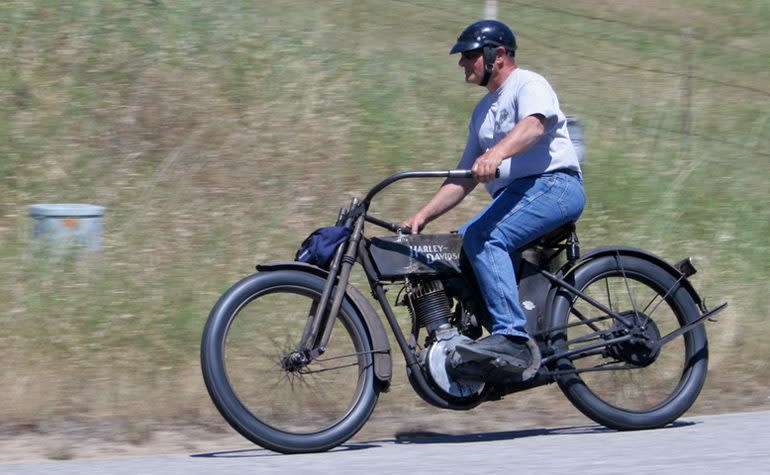
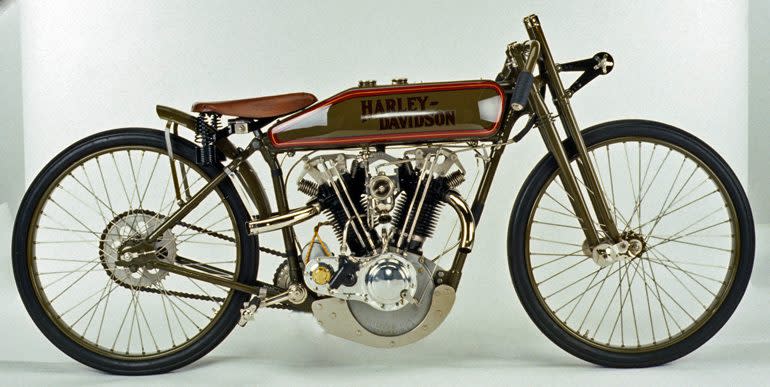
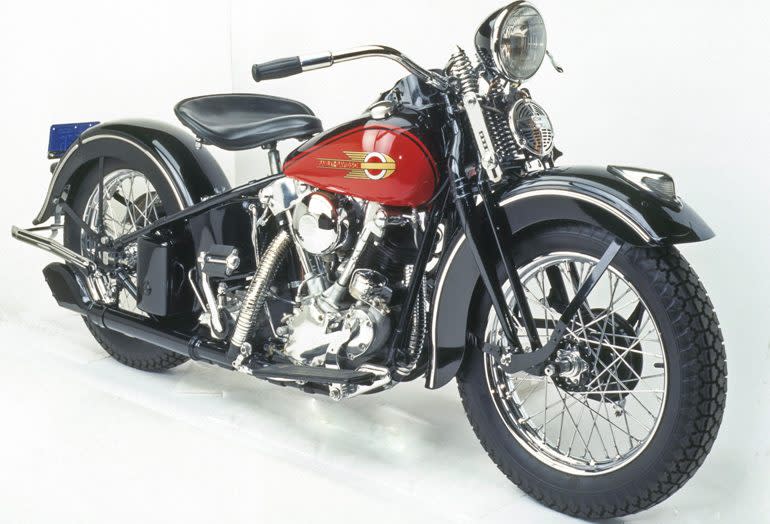
HAVERFORD (1909–1914) Philadelphia, Pennsylvania
HAWTHORNE (1911-1912) Chicago, Illinois
HENDERSON (1911–1931) Detroit, Michigan – In 1913, Carl Stearns Clancy became the first person to circumnavigate the planet on a motorcycle, which was a 1912 Henderson. William Henderson’s 965cc inline four made 7 horsepower, weighed about 325 lbs wet, and had a claimed top speed of 70 mph. It had a Bosch magneto, Eclipse clutch, enclosed chain drive and cost $325. The price of a Ford Model T was $590, but within four years had dropped to $345, when the two-speed Henderson sold for $295. In 1917 the fully equipped electrical model listed for $370. When Henry Ford bought one he asked for a discount, but was refused. Henderson was acquired by Excelsior the same year.
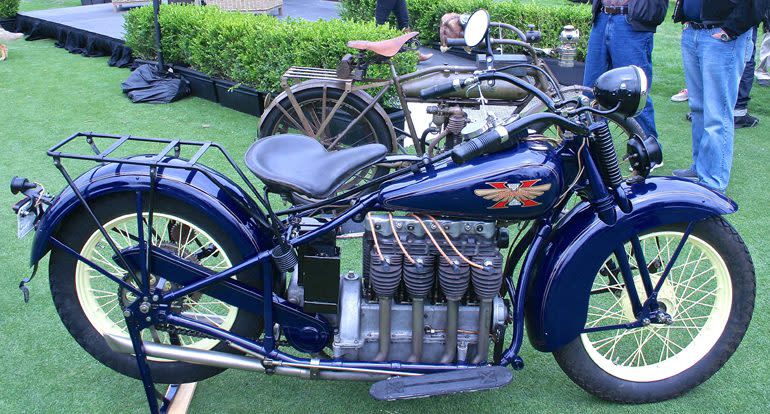
HERCULES (1902–1903) Hammondsport, New York
HILAMAN (1906–1912) Moorestown, New Jersey
HOFFMAN (1903-1904) Chicago, Illinois
HOLLEY (1902–1911) Bradford, Pennsylvania
(I)
INDIAN (1901–1953) Springfield, Massachusetts / (1963-1977) Los Angeles / (1999-2003) Gilroy, California / (2006-2011) Kings Mountain, North Carolina / (2011-present) Medina, Minnesota – George Hendee and Oscar Hedstrom were distinctly different personality types, but in combination their talents created the first large-scale American motorcycle company. (Though not “America’s first motorcycle company” as the current corporate assertion would have it.) Hendee was a top-rated bicycle racer, promoter and entrepreneur; Hedstrom was a racer as well, but also a designer/engineer who built motorized pacers for bicycle competition. His first prototype for the Hendee Manufacturing Co. was a bicycle frame incorporating a 213cc single in the seatpost tube. The engine was built by the Aurora Automatic Machine Co. of Illinois. The 1000cc Indian V-twin was ready in 1907, and would carry rider Teddy Hastings to victory in the inaugural 1000-mile Reliability Trial in England, precursor to the International Six Days Trial. Within five years the Indian Motocycle Co. was the world’s largest builder of two wheelers, rolling out 32,000 machines in 1913. Harley production had reached about 13,000, but the gap was closing.
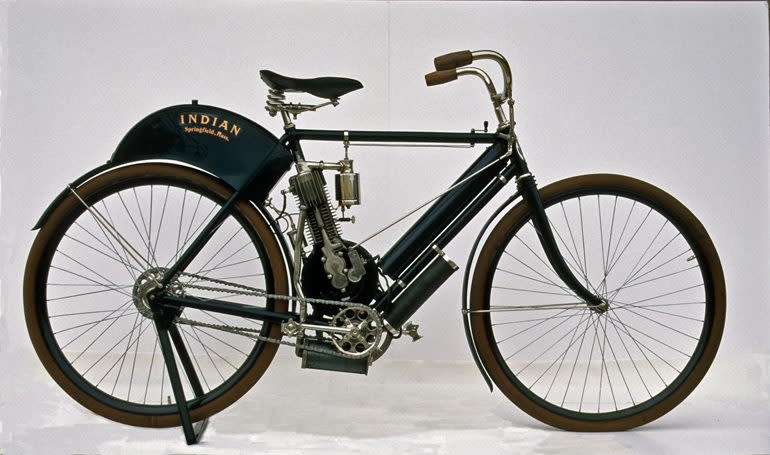
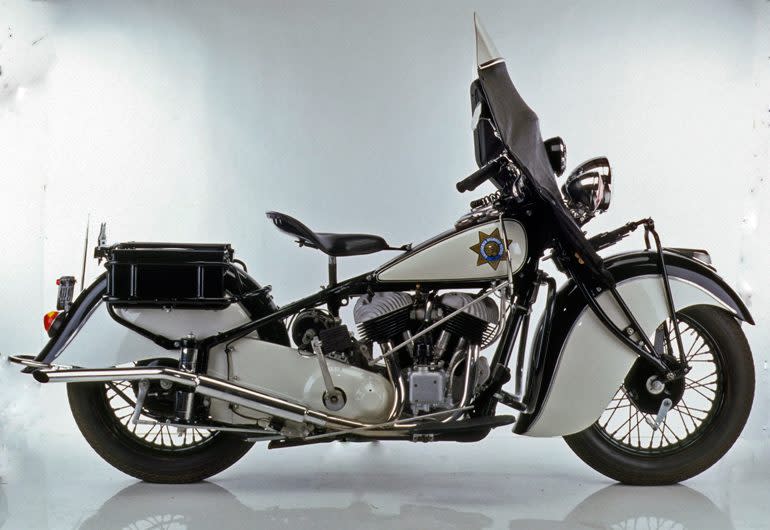
Milwaukee had shown little interest in racing, but finally admitted the sales benefits Indian had achieved through competition and established a racing department. Factory racing support, from both companies, would ebb and flow for the next 40 years. As the market changed after World War II, and Indian went through several corporate revisions, Harley emerged as the top choice for big domestic V-twins and Springfield ceased production in 1953. Floyd Clymer attempted a revival in the 60s, followed by decades of litigious disputes over trademark ownership, a failed start-up by the Gilroy-based California Motorcycle Company in 1998, and another by a London equity firm in 2006, the Indian marque came to rest at Polaris Industries in 2011. What went around… and now Harley is up against the latest generation of the same tribe, on the track and in the showroom.
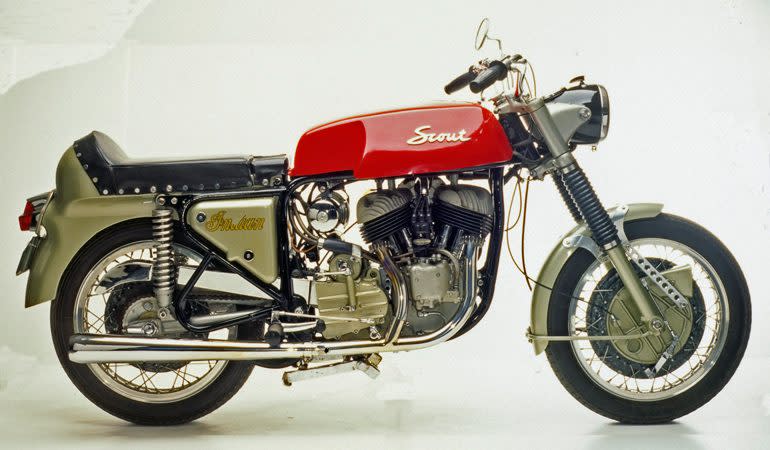

IVER-JOHNSON (1907–1916) Fitchburg, Massachusetts
(J)
JEFFERSON-WAVERLEY (1910–1914) Jefferson, Wisconsin
JOERNS (1910–1916) St.Paul, Minnesota
JOHNSON (1918–1922) ??
(K)
KEATING (1901–1902) Middletown, Connecticut
KEIFER (1909–1911) Buffalo, New York
KOKOMO (1909–1911) Kokomo, Indiana
(L)
LAMSON (1902–1903) Abington, Massachusetts
LANGFORD (1917–1921) Denver, Colorado
LA RAY (1946–1948) Milwaukee, Wisconsin
LIGHT (1901–1911) Pottstown, Pennsylvania – The Light was almost identical to the early Indian, with a Thor 213cc single fitted as the frame center post. Light acquired the Merkel Motor Co. in 1908, and three years later sold out to the Miami Cycle and Manufacturing Co. of Middletown, Ohio.
(M)
MACK (1909–1913) Milwaukee, Wisconsin
MALTBY (1902–1903) Brooklyn, New York
MANSON (1905–1908) Chicago, Illinois
MARSH (1900–1913) Brockton, Massachusetts – The Marsh brothers built their first motorized bicycle in 1899, and a 6hp single-cylinder racer in 1902 that was reportedly good for 60 mph. In 1905 they teamed with Charles Metz to become M.M. and built the first production 90-degree V-twin. The company expired in 1913 and Metz went on to build automobiles.
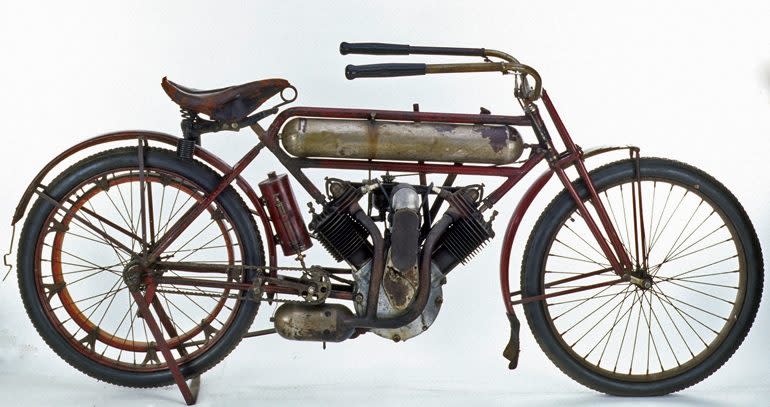
MARVEL (1910–1913) Hammondsport, New York
MAYO (1905–1908) Pottstown, Pennsylvania
MB (1916–1920) Buffalo, New York
MERKEL (1902–1915) Milwaukee, Wisconsin / Pottstown, Pennsylvania / Middletown, Ohio – Joseph Merkel was one of the industry’s first hot rodders, building engines and chassis that caught the attention of both Indian and Harley-Davidson. With an ace mechanic and rider named Maldwyn Jones, the Flying Merkel gave the factory team fits on the track, where most teams used the Merkel fork. A pioneer in the use of rear swingarm suspension, the company could claim “All roads are smooth to the Fllying Merkel.” The V-twin was offered in 885 and 1000cc version, with an optional two-speed planetary transmission.
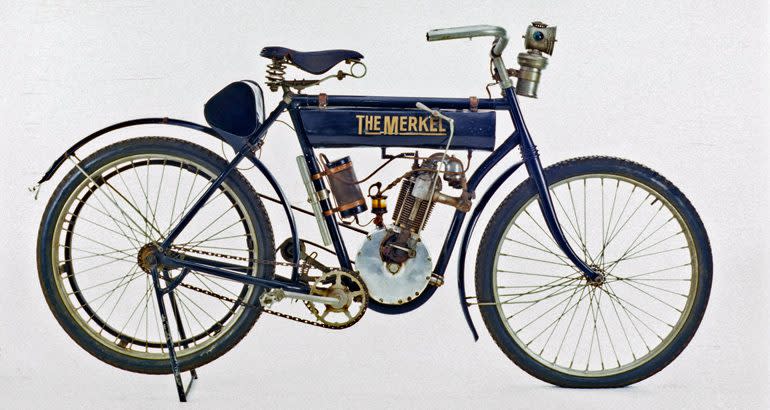
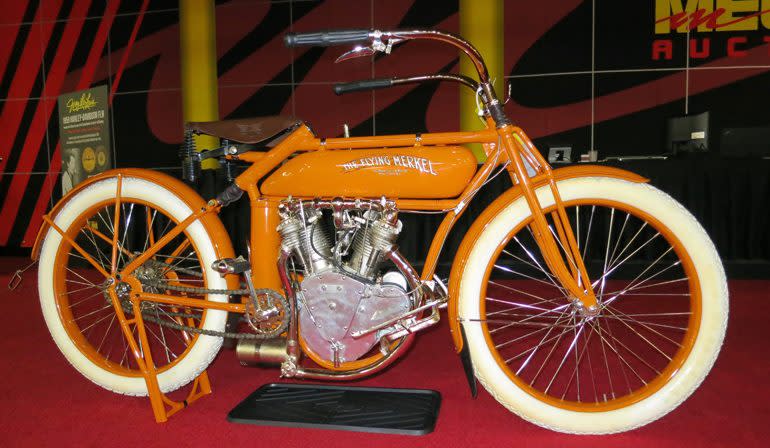
MIAMI (1915–1916) Middletown, Ohio
MICHAELSON (1908–1915) Minneapolis, Minnesota
MILITAIRE/MILITOR (1911–1922) Cleveland, Ohio / Buffalo, New York / Bridgeport, Massachusetts – The Militaire was a departure from conventional motorcycle engineering, with hub-center steering and retractable outrigger wheels at the rear. The 1065cc four made 11 horsepower, but the machine’s length, weight, and mechanical complexity were too far out of the mainstream. The final version had 1435cc OHV engine and was sold as a sidecar rig, but the engine had lubrication problems and the company called it quits in 1922.
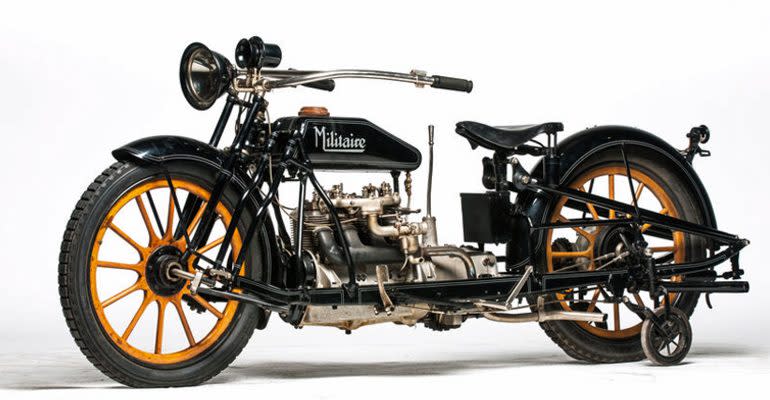
MINNEAPOLIS (1908–1914) Minneapolis, Minnesota
MITCHELL (1901–1906) Racine Junction, Wisconsin
MONARCH (1912-1915) Owego, New York
MORGAN (1901–1902) Brooklyn, New York
MOTORMASTER (1938–1939) Cleveland, Ohio
MOTO-SCOOT (1936–1949) Chicago, Illinois
MUSTANG (1946–1967) Glendale, California – Scooters and mini-bikes jumped in popularity after World War II. The Mustang was designed by sprint car racer Howard Forrest, with a 318cc flathead single that made 12 horepower and a featured telescopic front fork. Mustang and Cushman were the top contenders in the market for 20 years.
(N)
NELK (1905–1912) Palo Alto, California
NERACAR (1920–1927) Syracuse, New York
NEW-ERA (1909–1913) Dayton, Ohio
(O)
ORIENT (1900–1905) Waltham, Massachusetts – Charles Metz formed the Waltham Manufacturing Co. in 1893 to build Orient bicycles. The first engine-driven Orients were trikes powered by French Aster and DeDion engines. The final singles and V-twins were powered by Orient’s own engines with aluminum crankcases.
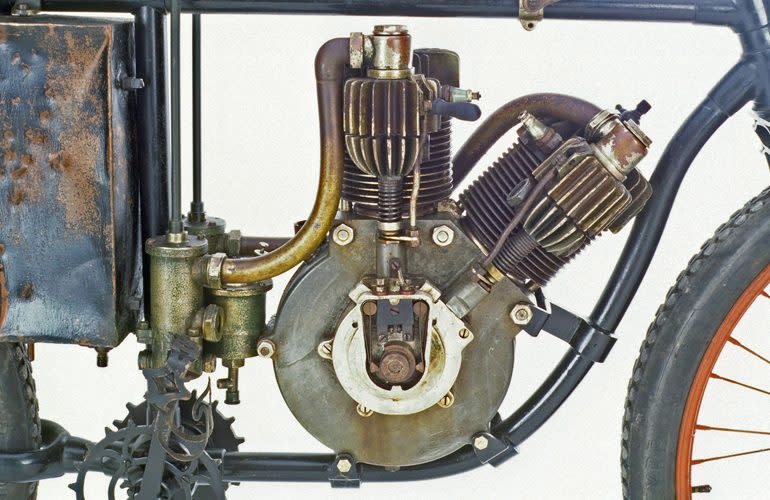
(P)
PEERLESS (1912–1916) Boston, Massachusetts
PEM (1905-1912) Jefferson, Wisconsin
PIERCE (1909–1913) Buffalo, New York – George Pierce built high-end cars and bicycles, and his son, Percy, added engines to the two-wheelers after examining the Belgian FN four. Pierce’s two-cam inline engine was part of the frame, and it was the first American machine to use shaft drive. The frame tubes carried the gas and oil, and the 696cc engine was reportedly good for 55 mph. But the original American four was too expensive in a crowded market, and the assembly plant was converted to produce Pierce-Arrow trucks.
PIONEER (1908–1910) Worcester, Massachusetts
PIRATE (1912–1915) Milwaukee, Wisconsin
POPE (1911–1918) Hartford, Connecticut / Westfield, Massachusetts – Lt. Col. Albert Augustus Pope (Union Army) was a prominent figure in early car and bicycle manufacturing. His bicycles and motorcycles were marketed under various brand names, but only as Popes in 1911, two years after his death. The OHV 1000cc V-twin was stout, with roller bearing connecting rods, Eclipse multi-disc clutch, two-speed transmission, leaf spring front fork and plunger rear suspension.
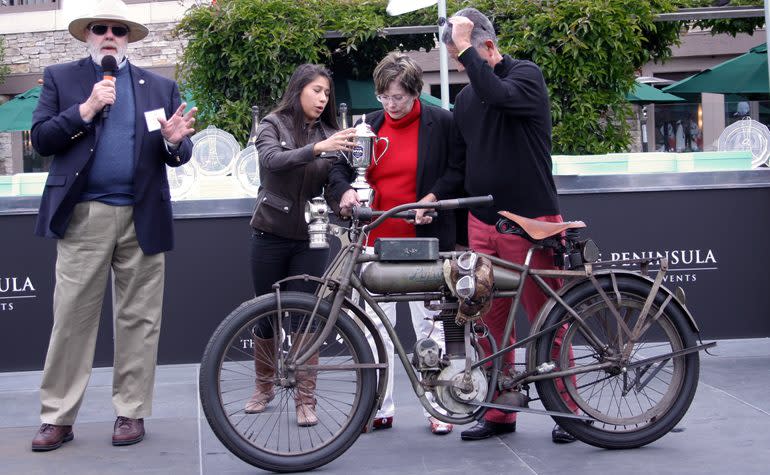
POWELL (1939–1952) Compton, California
PRATT (1911–1912) Elkhart, Indiana
(R)
RACYCLE (1905–1911) Middletown, Ohio
RAMBLER (1903–1914) Hartford, Connecticut
READING-STANDARD (1903–1922) Reading, Pennsylvania – The first Reading-Standards were Indian knock-offs, but in 1906 they introduced the first production side-valve engine in the States, designed by Charles Gustafson. He introduced a unique V-twin in 1908, but left soon after to work for Indian. The twin set a mile record at 77 mph in 1909. The company was sold in the 1920s to the Cleveland Motorcycle Manufacturing Co.
REDMAN (1902–1909) ??
RELIANCE (1908–1915) Addison/Owego/Elmira, New York
ROCK-OLA (1938–1940) Chicago, Illinois
ROKON (1962–present) Keene, New Hampshire – The original two-wheel drive mule, the fat-tired outback workhorse was powered by a 134cc Chrysler two-stroke twin. The RT-340 enduro had a Sachs two-stroke single with automatic transmission and a pull starter. The enduro went out of production in 1979, but the “go anywhere” mule is still in production, powered by a 208cc Kohler four-stroke single. The Scout has 13 inches of ground clearance and will climb a 60 percent grade.

ROLLAWAY (1919–1925) Toledo, Ohio
ROYAL (1909–1910) Worcester, Massachusetts
RUPP (1960–1974) Mansfield, Ohio
(S)
SAFTI-CYCLE (1946–1950) La Crosse, Wisconsin
SALSBURY (1936–1951) Oakland, California
SCHICKEL (1912–1924) Stamford, Connecticut
SEARS (1910–1916) Chicago, Illinois

SHAW (1903–1917) Galesburg, Kansas
SIMPLEX (1935–1960) New Orleans, Louisiana – The Simplex Servi-Cycle was designed by Joseph Treen, with a 125cc two-stoke single set low in the chassis. In 1953 the Simplex Automatic had a centrifugal clutch, leading link spring fork and footboards. The utility bike served as the introduction to motorcycle for many Americans following World War II.
SMITH MOTOR WHEEL (1914–1924) Milwaukee, Wisconsin
SPRINGCYCLE (1938–1942) Los Angeles, California
STAHL (1902–1907) Philadelphia, Pennsylvania
STEARNS (1901-1902) ???
STEEN (1962–1975) Alhambra, California
STEFFEY (1900–1905) Philadelphia, Pennsylvania
(T)
THIEM (1900–1913) St. Paul, Minnesota
THOR (1902–1917) Aurora, Illinois – As original engine supplier for Indian and other makers, Thor introduced its own motorcycle in 1907. In 1908 they brought out a V-twin with the engine canted so the rear cylinder was vertical. The 1190cc 1910 version was mounted in conventional fashion, had mechanical intake valves, and set several dirt track records. In 1915 rider Bill Briers finished second to Indian star Glen Boyd in the grueling Dodge City 300. The final 1000cc Thor V-twin was developed by engineer Bill Ottoway, who was hired away by Harley-Davidson to head up their newly formed racing department.
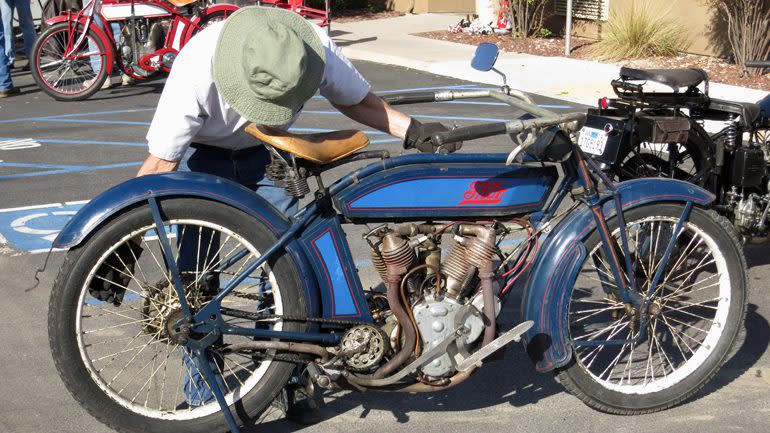
THOROUGHBRED (1904–1905) Reading, Pennsylvania
TIGER (1906–1909) New York, New York
TIGER AUTOBIKE (1915-1916) Chicago, Illinois
TINKHAM (1898–1899) New Haven, Connecticut
TORPEDO (1907–1910) Whiting, Indiana
TORQUE (1943–1945) Plainfield, New Jersey
TOURIST (1905–1907) Newark, New Jersey
TRIBUNE (1903–1914) Hartford, Connecticut
TRIUMPH (1908–1912) Chicago, Illinois/Detroit, Michigan
(V)
VALIANT (1964–1965) ???
VICTORY (1998–2017) Medina, Minnesota – The Victory was the first motorcycle entry for Polaris, large manufacturer of snowmobiles, watercraft and all-terrain vehicles. The objective was to challenge the supremacy of Harley in the big V-twin market, a goal that many riders say they achieved. The initial 1507cc engine made sufficient grunt and the chassis was fitted with top shelf suspension and brake components. The marque was discontinued in 2017 when Polaris decided to focus efforts on the Indian brand, a perspective that seems to be paying off.


(W)
WAGNER (1901–1914) St. Paul, Minnesota – George Wagner designed a chassis using components of the bicycle diamond-shape frame and the full-loop frame for strength and weight distribution. His 442cc four-stroke single sat low in the chassis, and the front down tube was also the exhaust header. The final 475cc engine made four horsepower, which urged the 250 lb machine to 50 mph. The price was $200.
WAVERLEY (1905–1912) Jefferson, Wisconsin
WESTFIELD (1916–1918) Westfield, Massachusetts
WESTOVER (1912–1913) Denver, Colorado
WHIPPLE (1903–1905) Los Angeles, California
WHIZZER (1939–1962) Los Angeles, California – Like the Simplex, the Whizzer launched many a young rider on the road to motorcycling. First sold in kit form as an attachment motor, the 138cc single didn’t make much power, but could be fitted to a Schwinn bicycle by a kid with ambition. The company moved from Los Angeles to Michigan in the 1940s, horsepower inched up, and a complete motorbike, the Pacemaker, went on the market.
WILLIAMS (1912–1916) New York, New York

WILLIAMSON (1902–1903) Philadelphia, Pennsylvania
WYSECYCLE (1947–1950) Dayton, Ohio
(Y)
YALE (1902–1915) Toledo, Ohio
YANKEE (1922–1923) Chicago, Illinois
(Z)
ZERO (2006–present) Scotts Valley, California – Electric motorcycle company founded by former NASA engineer Neal Saiki. Improvements in battery capacity, travel range and recharge time have shown steady progress, while competitive pricing remains a major issue.
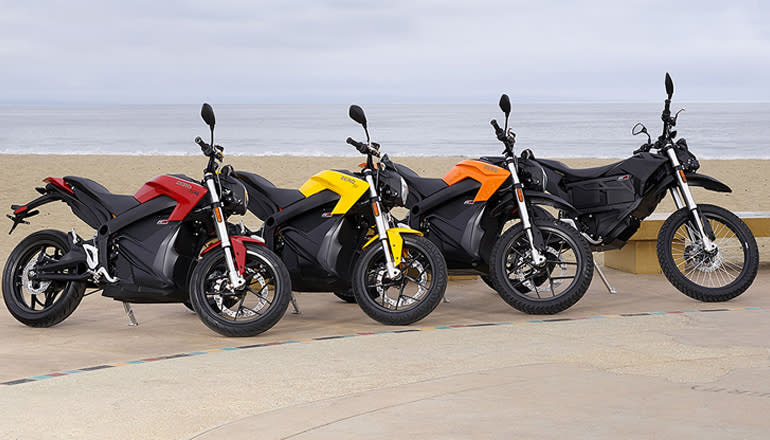
References: “The American Motorcycle, 1869–1914,” Stephen Wright, Megden Publishing Co., 2001.
“The Complete Illustrated Encyclopedia of American Motorcycles,” Tod Rafferty, Courage Books, 1999


